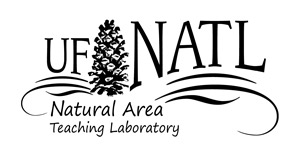| UF Academic Use | Public Use | Family Fun and K-12 Education |

Management, Maintenance, and Funding of NATL: 1994-2004
Thomas J. Walker, Chair, Natural Area Advisory Committee
20 September 2004
Why this document
The Natural Area Teaching Laboratory(NATL) is an outdoor academic facility that occupies 46 acres in the southwest corner of campus and serves students in at least 75 courses, taught in nine departments in four colleges (1). In addition it is an important adjunct to the Florida Museum of Natural History, which uses it extensively for environmental education of K-12 groups, and to the Cultural Complex, which uses Natural Area Park as an inviting place for the public to rest in the shade or to access portions of NATL (2). Yet 10 years ago, this 46 acres was largely unknown and unused. The progress made during these 10 years (3) reflects well on the procedures that evolved to manage, maintain, and fund NATL. However, with the increasing use of NATL and the prospect of its expansion (4), current procedures need to be re-evaluated. Therefore, between now and the end of the year, the Natural Area Advisory Committee will consider what changes it should recommend. Anyone who wishes to contribute to the Committee's deliberations may do so by contacting us.
Past and present procedures
In 1993, a group of faculty proposed that a large, undeveloped tract in the southwest corner of campus be designated as a "campus natural area and outdoor teaching laboratory." In September 1994, with encouragement from IFAS Dean Larry Connor, the group became the Natural Area Advisory Committee (NAAC) and set about seeing that its proposals were implemented. It soon adopted operating policies (5) and refined the plan described in its original proposal (6).
Management
NAAC pushed ahead with no formal administrative supervision until the fall of 1996 when it proposed that a fence be built along NATL's south and east borders and learned that planning and building such a fence required approval of UF's land-use committees. At that time NAAC sought and received the support of the Lakes, Vegetation & Landscaping Committee (LVL), which was charged with "the management and well-being of natural areas containing non-domesticated plants and animals." It was agreed that the NAAC would keep LVL informed of it activities and that the chair of LVL would become a voting ex officio member of the NATL Advisory Committee. Major projects, such as the fence, would be reviewed by LVL before going to the Land Use and Facilities Planning Committee. In 2001, Provost Colburn approved this statement of the role of NAAC in NATL management (7):
"The Natural Area Advisory Committee (NAAC), consisting of at least one representative from each department or other unit making significant use of NATL and the Chair of the Lakes, Vegetation and Landscaping Committee, will recommend management plans and seek their implementation. Each fall the Chair of NAAC will send a written report of the Committee's activities for the previous school year to appropriate administrators and will report in person to the Lakes, Vegetation, and Landscaping Committee."
Maintenance
From 1994 until 2001, routine maintenance and development labor was supplied almost entirely by volunteers from NAAC and student organizations. This included clearing the successional plots, cutting and girdling laurel oaks to help restore the upland pine, and applying herbicides to invasive exotic plants. NATL's trails were mowed by faculty members and their departmental employees. In 2001, after lengthy deliberations by UF administrators, Provost Colburn approved this statement as to how NATL should be maintained (7):
"NAAC and PPD will work cooperatively to ensure the maintenance of NATL. Each will do those tasks that it can handle most efficiently. The Chair of NAAC will communicate directly with PPD and the Vice President of Administrative Affairs regarding maintenance of NATL."
This provision has worked exceedingly well. PPD, with some help from IFAS, does the mowing that is needed, and PPD tends to all work orders phoned in by the NAAC Chair. NAAC continues to take care of routine chores that require no heavy machinery, such as clearing trails of fallen trees and transplanting and watering wiregrass and longleaf pines in the upland pine.
Funding
NATL has no line in the UF budget. NAAC raised the $116,290 required for its major projects by asking various administrators and an outside agency to pledge funds toward the estimated costs (8). During NAAC's first seven years, it funded its routine expenditures with $1600 from private donors and $3305 from overages from its major projects. During each of the past three years NAAC has received $1000 for expenses from the Provost. A complete accounting of NAAC finances, from 1994 to date, is on the NATL web site (9). In 2001, Provost Colburn approved this statement as to how NATL should be funded (7):
"NAAC will ask the Provost for funds to cover its routine operations. Each such request will be accompanied by a report of all NAAC expenditures not previously documented. For major projects, NAAC will also request the Provost's support, but with copies to the Vice President of Administrative Affairs, the Vice President for Agriculture and Natural Resources, and the Deans of the Colleges of Agricultural and Life Sciences, Liberal Arts and Sciences, Engineering, and Education."
Numbered notes:
When viewed on the web, the numbered notes in this document are linked to these URLs:
(1) http://natl.ifas.ufl.edu/natluses.pdf
(2) http://natl.ifas.ufl.edu/photogallery/nap.php
(3) http://natl.ifas.ufl.edu/photogallery/improvements.php
(4) http://natl.ifas.ufl.edu/photogallery/improvements.php#P2
(5) http://natl.ifas.ufl.edu/management/index.php#OpPolicies
(6) http://natl.ifas.ufl.edu/docs/cnaprop.pdf
(7) http://natl.ifas.ufl.edu/history.php#manage
(8) http://natl.ifas.ufl.edu/docs/MajorProj$$.pdf
(9) http://natl.ifas.ufl.edu/docs/NATL$$.xls


